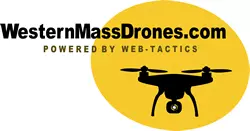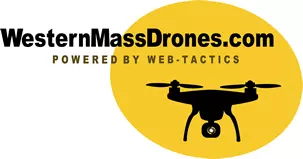Preserving History with Drone Photography
However, maintaining these buildings can be tricky. Over time, small problems, like crumbling mortar or leaking roofs, can become significant expenses if not caught early. This is especially challenging for tall or complex structures where traditional inspections are difficult and costly.
Drone photography offers a practical solution by providing a safe, efficient way to examine these structures without scaffolding or heavy equipment. For churches, municipal buildings, and other heritage sites, drones are helping reduce the risks and costs involved in regular maintenance.
Western Mass Drones is proud to support these efforts. Using drone photos and videos, we provide detailed visuals to help property managers, contractors, and preservationists make informed decisions. One recent example is our work with Christ Episcopal Church in Guilford, Connecticut, where we inspected the bell tower to help guide repairs and future maintenance.
This post will explore how drones transform the way heritage buildings are inspected, with practical insights and examples to help property owners take proactive steps to preserve their structures.
The Importance of Routine Inspections for Heritage Sites
Maintaining historic buildings is essential, but it comes with unique challenges. Over time, materials like wood, metal, and mortar degrade due to weather and general wear. These minor issues can lead to more serious structural problems if unnoticed. For example, loose flashing or damaged wood can allow moisture to seep into walls, causing rot or mold. The cost of emergency repairs often far outweighs what it would take to address these problems early on.
One of the biggest hurdles in maintaining these structures is access. Many historic buildings feature tall towers, spires, and intricate designs that are hard to reach safely. Traditional inspection methods, like scaffolding or lift equipment, are not only expensive but can also disturb fragile materials. This can lead to further damage, especially with aging structures.
Routine inspections are crucial because they allow building managers and preservation teams to monitor the condition of critical elements like roofing, woodwork, and masonry. By identifying problems before they grow, these inspections help extend the lifespan of the building and ensure it remains safe for future generations.
Drone photography offers an intelligent way to overcome these challenges. With drones, inspectors can quickly and safely gather high-quality images and videos of areas that are otherwise difficult to reach. This allows decision-makers to plan repairs and maintenance without delay, saving time, money, and effort.
Case Study: Drone Inspection at Christ Episcopal Church, Guilford, Connecticut
Recently, Western Mass Drones had the opportunity to support Christ Episcopal Church in Guilford, Connecticut, by inspecting its historic bell tower. The church was planning repairs and needed detailed information about the condition of specific elements to prioritize maintenance efforts effectively.
Using drones, we captured high-resolution photos and videos to evaluate critical areas of the tower:
-
Mortar Condition: Cracks and erosion in the joints can weaken the structure, especially after years of exposure to the elements. The drone allowed us to get close-up shots to assess where repairs might be needed.
-
Metal Cap Assessment: The metal cap at the top of the tower plays an essential role in keeping water out. We inspected its condition through aerial photography to determine whether it required repairs or replacement.
-
Wooden Louvers Inspection: The louvers, designed to allow airflow through the tower, are prone to wear over time. Our drone footage clearly showed any damage or decay that needed attention.
-
Roof Flashing Analysis: We paid close attention to the flashing on the south side, where the tower meets the sloped roof. This area is particularly vulnerable to water leaks. The drone made it easy to inspect this tricky spot without disturbing the roof’s structure.
This drone inspection gave the church the necessary insights to plan their repairs efficiently, saving time and avoiding unnecessary costs. By addressing these issues now, they are protecting their tower from further damage and ensuring it will continue to serve the community for years to come.
The success of this project shows how drone technology can provide the precision and depth needed for maintaining heritage buildings—without the high costs or risks associated with traditional inspection methods.
Benefits of Drone Photography for Inspections
Drone photography offers several advantages for inspecting historic buildings, especially when accessing hard-to-reach areas safely and efficiently. Below are some of the ways drones are making a difference for heritage sites:
-
Non-Invasive Inspections: Traditional inspections often require scaffolding or lifts, which can be expensive and disruptive. These methods carry additional risks for historic buildings, as scaffolding can place stress on aging materials. Drones eliminate the need for such setups, ensuring that inspections don’t disturb delicate structures.
-
High-Resolution Visuals for Precise Assessment: Drones capture detailed images and videos, providing close-up views of areas that might go unnoticed. With these visuals, contractors and maintenance teams can identify cracks, corrosion, or other signs of deterioration that would be difficult to spot from the ground.
-
Thorough Coverage of Complex Structures: Bell towers, spires, and steep rooftops are common features of heritage buildings but present unique challenges for inspectors. Drones can fly around and above these features, capturing multiple angles to ensure nothing is overlooked. This level of coverage can reveal hidden vulnerabilities, such as cracks in flashing or weakened mortar joints.
-
Cost and Time Savings: By streamlining the inspection process, drones help reduce the time and manpower needed to complete assessments. This translates into significant cost savings, especially for nonprofit organizations or small communities managing historic buildings on limited budgets. Identifying issues early also means avoiding the higher costs of emergency repairs.
-
Enhanced Safety: Drone inspections keep workers safe by reducing the need for climbing or working at height. This is especially important for tall structures, where the risks of injury increase with traditional inspection methods. With drones, inspectors can gather the information they need without putting themselves in harm’s way.
These benefits make drone photography a valuable tool for heritage sites. By providing efficient, detailed, and safe inspections, drones help building managers make informed decisions that protect these structures for the long haul.
Why Churches and Historic Buildings Should Consider Drone Inspections
For churches and heritage buildings, staying ahead of maintenance needs is essential. These structures are often unique, with architectural details that require careful upkeep. Drone photography offers an intelligent solution for property managers, preservation groups, and communities looking to care for these buildings without breaking the bank.
-
Tailored to the Needs of Churches and Heritage Sites: Churches often feature tall towers, bell chambers, and steeples that are difficult to inspect using traditional methods. Scaffolding adds to the cost and can disrupt daily activities, such as services or events. Drone inspections offer a hassle-free way to gather the information needed to plan repairs without inconveniencing the community.
-
Preserving Architectural Integrity: Many historic buildings are fragile, with aged materials that can be easily damaged during manual inspections. By using drones, inspectors can access vulnerable areas without physically interacting with them, minimizing the risk of harm to the building. This non-invasive approach ensures the structure stays intact while receiving the attention it needs.
-
Comprehensive Documentation for Long-Term Planning: Drone photography provides more than a momentary snapshot. The images and videos captured during inspections create a valuable record that can be referred to over time. These visuals make it easier to track how a building’s condition changes from year to year, allowing property managers to prioritize repairs and plan future maintenance proactively.
-
A Practical Choice for Communities with Limited Resources: Many churches and historic properties operate on tight budgets, relying on donations or public funding to cover maintenance costs. Drone inspections offer an affordable way to stay on top of repairs without sacrificing quality. By identifying problems early, these inspections help avoid unexpected expenses and emergency repairs, making it easier to manage upkeep within a budget.
Whether it’s a church tower, a historic town hall, or a cultural landmark, drone photography provides the tools needed to care for these important buildings with precision and care. It’s a practical, safe, and cost-effective solution, ensuring these structures remain standing for future generations.
How Western Mass Drones Can Support Your Building's Maintenance Needs
Caring for historic buildings requires the right expertise and tools, and that’s where we come in. With experience in inspecting various heritage structures, including the recent project at Christ Episcopal Church in Guilford, Connecticut, we understand the challenges in maintaining these buildings.
-
Local Knowledge and Expertise: As a Western Massachusetts-based business, we are familiar with the needs of the region’s historic properties. Our team works closely with churches, municipalities, and preservation groups to provide drone inspections tailored to each building’s unique structure and maintenance goals.
-
Tailored Inspection Services for Every Project: No two buildings are the same. Whether you need a detailed look at a steeple, bell tower, or sloped roof, we design our inspections to address your building’s concerns. We provide high-resolution visuals to evaluate mortar joints, flashing, metalwork, and more, giving you the information to plan maintenance confidently.
-
Efficient and Safe Inspections: We prioritize safety by eliminating the need for ladders, lifts, or scaffolding. Our drones can access high and hard-to-reach areas without putting anyone at risk while still delivering the detailed images and videos you need to make informed decisions.
-
Schedule a Consultation Today: If your church, town hall, or other heritage building could benefit from a drone inspection, we are ready to help. Contact Western Mass Drones today to learn more about our services and schedule a consultation. Together, we can ensure that your building remains safe, functional, and beautiful for years.

